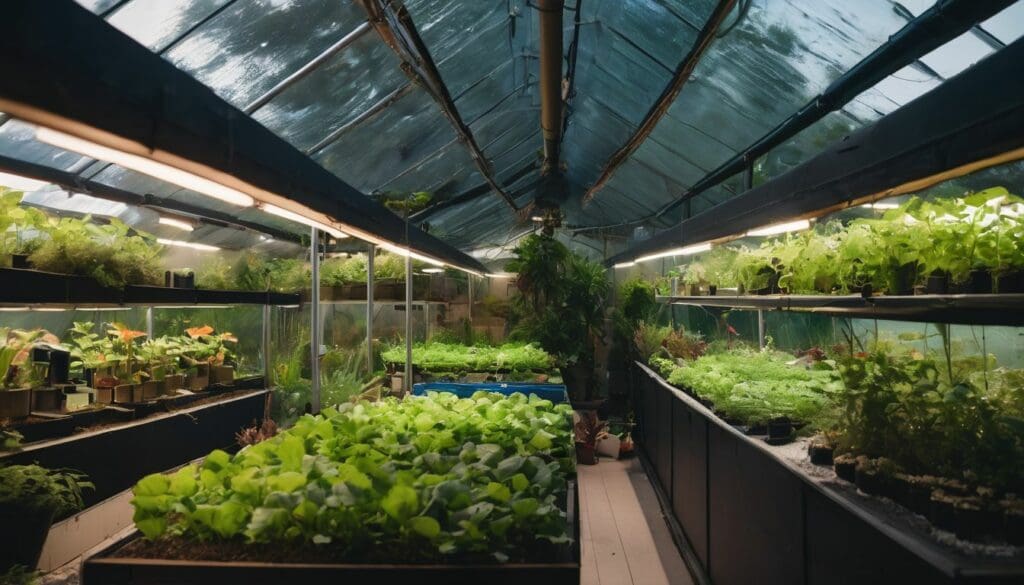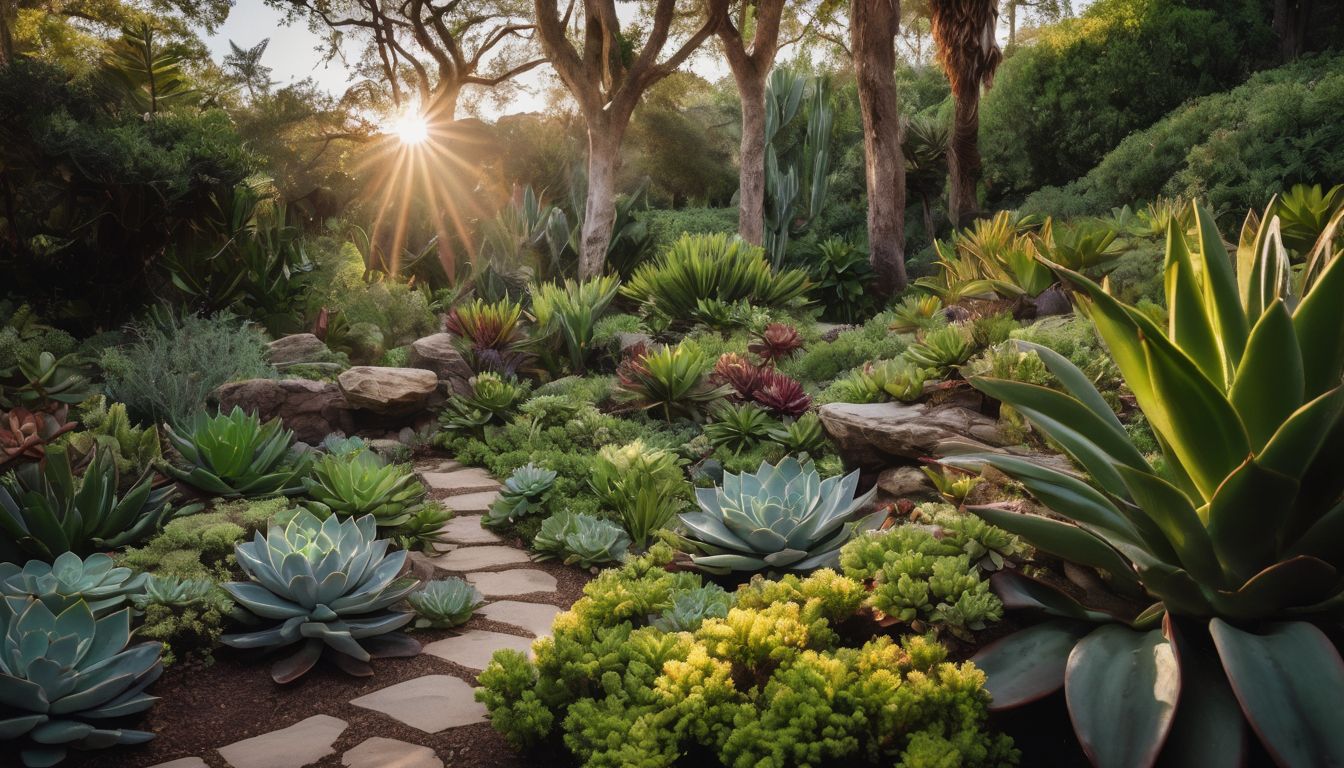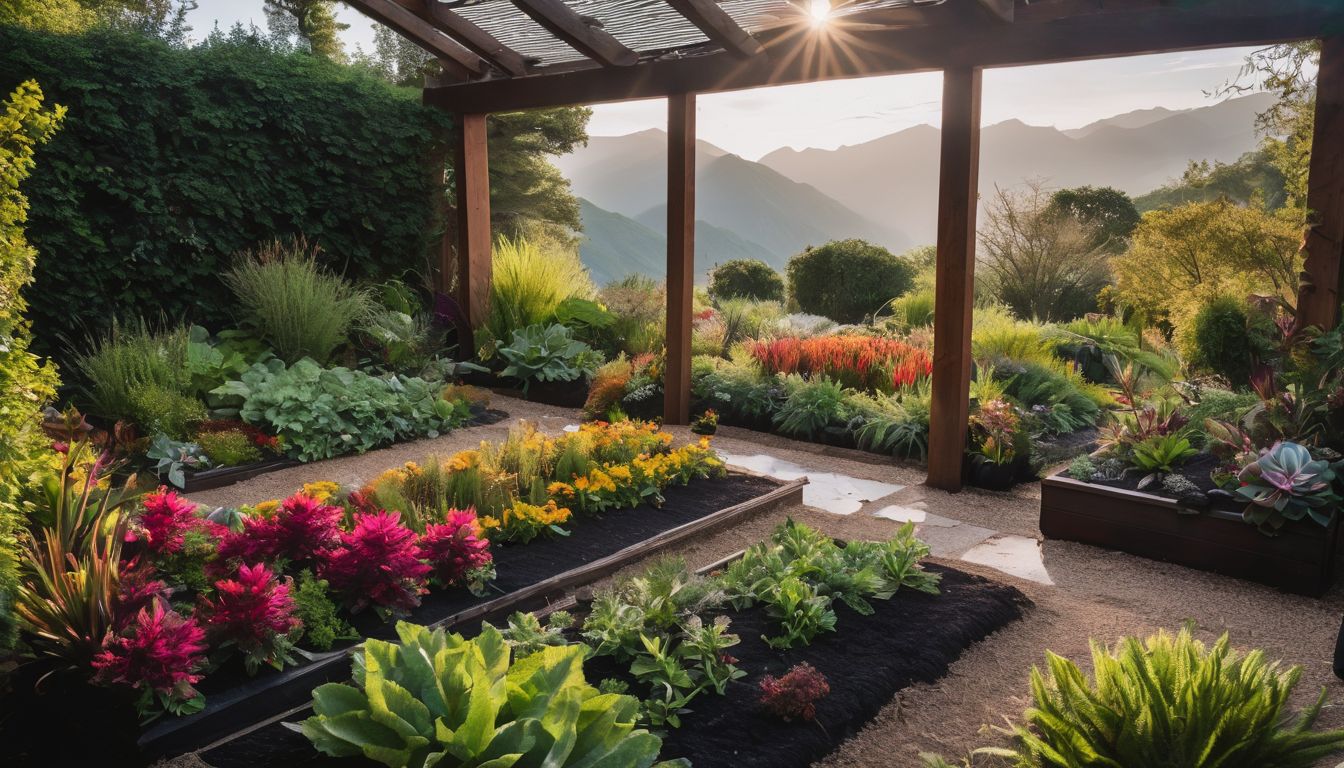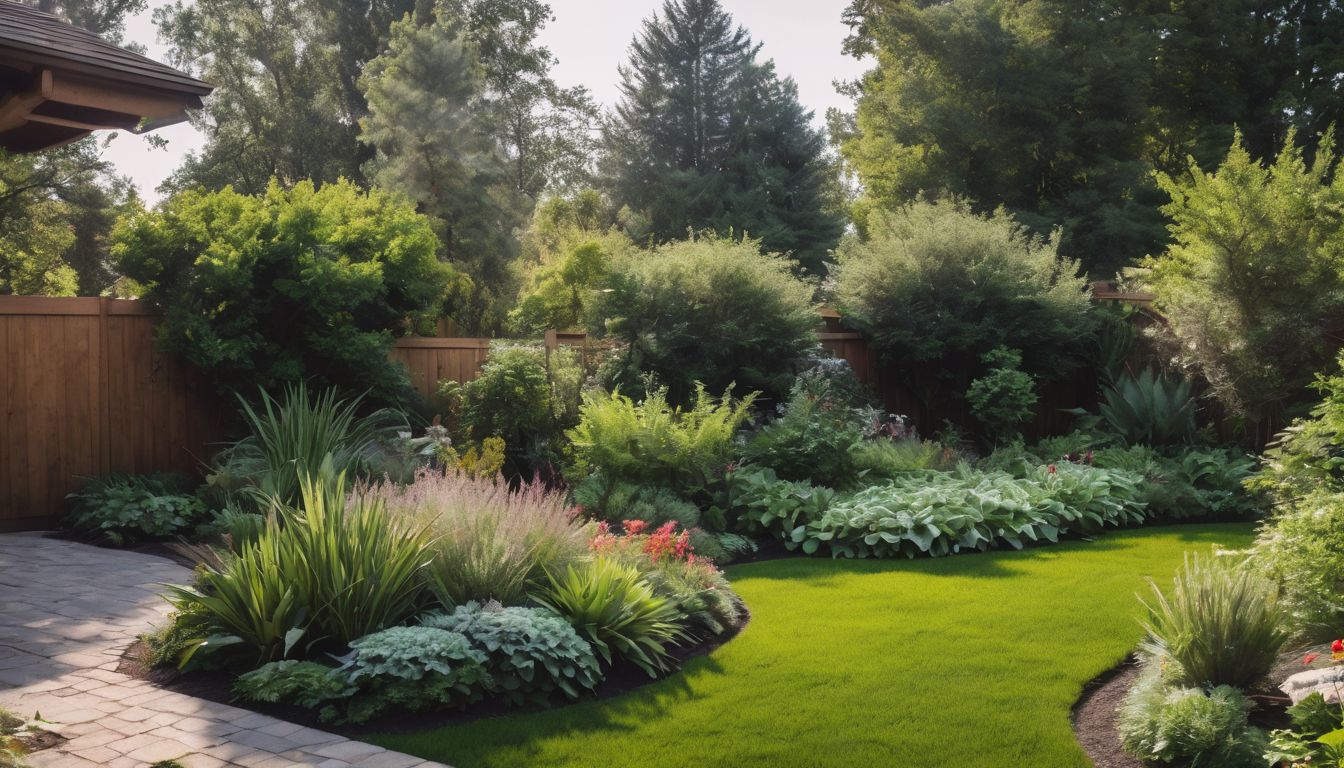Are you looking for a way to grow your own food while saving water and space? Aquaponic gardening allows plants and fish to thrive together in a mutually beneficial system. In this article, we’ll explore the simple basics of setting up an aquaponic garden that can yield fresh produce right at home.
Dive into nature’s synergy with us!
Key Takeaways
- Aquaponic gardening is a sustainable method that combines raising fish (aquaculture) with soilless plant cultivation (hydroponics). It creates a mutually beneficial system where fish waste provides nutrients for plants, and plants naturally filter the water.
- The system relies on nitrifying bacteria to convert ammonia from fish waste into nitrates that plants use to grow. Maintaining proper pH levels and ensuring adequate oxygen supply through aeration are crucial for the health of both fish and bacteria.
- Different types of aquaponic systems include media – based, deep water culture (DWC), and nutrient film technique (NFT), each suitable for different kinds of plants and space availability.
- Essential components of an aquaponic system include the fish, which provide nutrients; the plants, which clean the water; and bacteria, which convert ammonia into usable plant nutrients.
- Benefits of aquaponic gardening consist of high yields in a compact area using less water than traditional farming methods. The result is fresh produce grown in an eco-friendly way without synthetic fertilisers or pesticides.
Understanding Aquaponics
Aquaponics is a sustainable farming method that combines aquaculture with hydroponic growing, creating a closed-loop system. It relies on the nitrification process to convert fish waste into nutrients for plants and requires careful maintenance of pH levels and proper aeration.
Definition and principle
Aquaponics merges two efficient systems, aquaculture and hydroponic growing. In this symbiotic environment, fish produce waste that serves as a nutrient solution for plants. Plants use these nutrients to thrive, simultaneously cleaning the water, which is recirculated back to the fish tanks.
This closed loop system reduces the need for chemical fertilisers or filters, harnessing natural processes to grow food sustainably.
The principle behind this innovative farming technique lies in creating a balanced ecosystem where aquatic life and vegetables support one another’s growth. Such setups mimic natural wetlands where filtration happens through bioactive compounds in plant roots and soil microorganisms.
As we delve deeper into understanding aquaponics, let’s explore how the nitrification process plays a pivotal role in transforming fish waste into valuable plant nutrients.
Nitrification process
After understanding the basic principles of aquaponics, it’s essential to delve into the nitrification process. This biological process involves converting toxic ammonia from fish waste into nitrites and then into nitrates, which serve as valuable nutrients for plants.
Bacteria play a vital role in this process by transforming the harmful substances into beneficial elements that promote healthy plant growth. The nitrification process is crucial in maintaining the delicate balance within an aquaponic system, ensuring optimal conditions for both fish and plants to thrive.
As part of aquaponic gardening, sustaining a healthy environment for bacteria to carry out the nitrification process is paramount. By creating a suitable habitat through proper pH levels and adequate aeration, enthusiasts can support efficient conversion of fish waste into essential nutrients for plant growth.
Maintaining proper pH levels
To maintain proper pH levels in an aquaponic system, regularly test the water using a pH kit. Adjust the pH by adding either potassium hydroxide to raise it or phosphoric acid to lower it, ensuring the ideal range of 6.8 to 7.0 for optimal nutrient availability.
Additionally, monitor any fluctuations and make gradual adjustments as sudden changes could stress your fish and plants.
Maintain proper pH levels by incorporating natural buffers like crushed coral or oyster shells into the system to prevent drastic shifts that can harm the delicate balance of your aquaponic environment.
Importance of aeration
When maintaining proper pH levels in an aquaponic system, it’s essential to recognise the importance of aeration. Effective aeration ensures that oxygen is adequately distributed in the water, benefiting both fish and plants.
Oxygen supports the growth of beneficial bacteria that convert fish waste into nutrients for plants, ultimately promoting a healthy symbiotic environment. Additionally, proper aeration helps prevent the accumulation of harmful gases and ensures optimal nutrient uptake by plants, resulting in higher yields and overall system health.
Adequate aeration also promotes efficient nitrification, enhancing the breakdown of toxic ammonia produced by fish waste. This crucial process not only maintains water quality but also supports the well-being of aquatic life within the system.
Types of Aquaponic Systems
Different types of aquaponic systems include media-based, deep water culture, and nutrient film technique. Each system has its own advantages and requirements for setup and maintenance.
To learn more about the various types of aquaponic systems, continue reading below.
Media-based aquaponics (flood and drain)
In media-based aquaponics (flood and drain), the grow bed is filled with a medium like gravel or clay pebbles. The water from the fish tank floods the grow bed, allowing the plants to absorb nutrients, and then drains back into the fish tank.
This continuous cycle provides an oxygen-rich environment for both the plants and fish while also facilitating efficient nutrient uptake.
The flood and drain method in media-based aquaponics ensures that plant roots have access to oxygen, preventing root rot and promoting healthy growth. This system is popular among beginners due to its simplicity and effectiveness in supporting a wide variety of plants.
Deep water culture (DWC)
Deep water culture (DWC) is a hydroponic method where plants are grown directly in nutrient-rich water. The roots of the plants are submerged in oxygenated water, allowing them to absorb nutrients and oxygen efficiently.
This system is commonly used for growing lettuce, herbs, and other leafy greens. A large reservoir holds the nutrient solution while an air pump provides necessary aeration to support plant growth.
By utilising DWC in aquaponics, you can create a balanced ecosystem where fish waste provides essential nutrients for plant growth, and the plants filter and purify the water for the fish.
This symbiotic relationship between fish and plants results in sustainable food production that conserves water and fosters environmental harmony.
Nutrient film technique (NFT)
Transitioning from deep water culture (DWC) to nutrient film technique (NFT), this method involves a continuous flow of nutrient-rich water along the bottom of a narrow channel, letting the plants’ roots absorb what they need.
With NFT, there is no soil involved – just a thin film of water carrying essential nutrients for the plants. This efficient system conserves water and space while promoting healthy plant growth.
Nutrient film technique offers an excellent opportunity for environmentally conscious individuals to cultivate aquatic plants sustainably, supporting conservation efforts.
Components of an Aquaponic System
The components of an aquaponic system include fish, plants, and bacteria. These work together in a symbiotic relationship to create a sustainable and eco-friendly gardening system that produces high yields.
Fish
Fish play a crucial role in aquaponic systems, serving as the source of nutrients for the plants. The waste produced by fish is broken down into nitrites and nitrates by beneficial bacteria, which are then absorbed by the plants as essential nutrients.
This symbiotic relationship between the fish and plants creates a self-sustaining ecosystem. Popular fish species used in aquaponics include tilapia, trout, catfish, and carp. These fish are chosen for their ability to thrive in closed aquatic environments while producing ample waste to nourish the plants.
In aquaponic gardening, it’s essential to select suitable fish species that can adapt well to the system’s environmental conditions. The choice of fish should also align with the desired production goals and local regulations concerning aquaculture.
Plants
Aquaponic gardening involves a range of plants that thrive in the nutrient-rich environment provided by fish waste. Leafy greens, herbs, and some fruiting plants like tomatoes can flourish in this system.
The plant roots absorb nutrients from the water, effectively filtering it for the fish while benefitting from an organic food source.
The symbiotic relationship between the plants and fish creates a sustainable ecosystem where both elements mutually support each other’s growth. Nutrient-rich water from the fish tanks is continuously cycled through grow beds to provide essential minerals for optimal plant development.
Bacteria
After understanding the role of plants in an aquaponic system, it’s crucial to recognise the significance of bacteria. Bacteria play a vital role in converting fish waste into nutrients that can be utilised by plants for their growth.
These beneficial bacteria thrive in the grow bed, where they break down ammonia into nitrates through a process called nitrification, which serves as an essential nutrient source for the plants.
By establishing a healthy colony of bacteria within the aquaponic system, you ensure optimal conditions for both plant growth and fish health. Proper maintenance and monitoring of these bacteria are fundamental to sustaining the symbiotic relationship between fish and plants in your aquaponic garden.
Benefits of Aquaponic Gardening
Aquaponic gardening offers high yields and is easy to maintain, making it an eco-friendly and sustainable option for those interested in organic gardening. With the symbiotic relationship between fish and plants, aquaponics provides a natural way to grow food while conserving water.
High yields
Aquaponic gardening results in high yields of fresh, nutritious produce. The symbiotic relationship between fish and plants creates a self-sustaining ecosystem that fosters rapid growth.
This method harnesses the natural nutrients from fish waste, providing a nutrient-rich environment for plant growth without the need for additional fertilisers or chemicals. With proper maintenance and care, aquaponic systems consistently yield bountiful crops while minimising environmental impact.
The efficient use of resources in aquaponic gardening leads to impressive yields of organic fruits, vegetables, and herbs. By utilising this innovative approach to sustainable farming, individuals can enjoy an abundance of homegrown produce while reducing their ecological footprint.
Easy to maintain
Aquaponic systems are easy to maintain, requiring minimal effort for upkeep. Regular monitoring of water quality and pH levels is crucial but can be easily managed with simple testing kits.
Additionally, maintaining proper aeration and ensuring the well-being of fish are also essential tasks that can be achieved without much difficulty. The low-maintenance nature of aquaponics makes it an attractive option for those looking to grow their own produce in an efficient and sustainable manner.
Furthermore, the symbiotic relationship between fish and plants creates a self-sustaining ecosystem that reduces the need for constant intervention, contributing to its overall ease of maintenance.
Sustainable and eco-friendly
Aquaponic gardening is a sustainable and eco-friendly method of food production, using 90% less water than traditional agriculture. By combining aquaculture with hydroponics, it creates a closed-loop system where fish waste provides nutrients for plant growth, while the plants filter and clean the water for the fish.
This symbiotic relationship minimises environmental impact and promotes efficient resource use, making it an ideal choice for environmentally conscious individuals looking to support conservation efforts.
With its minimal water usage and organic growing methods, aquaponic gardening aligns closely with permaculture and urban farming principles. It also supports water conservation by reusing nutrient-rich water instead of letting it go to waste.
Step-by-Step Guide to Setting Up an Aquaponic System
Prepare the fish tank and grow bed, cycle the system and establish a bacteria colony, and maintain the system for water quality and fish health. Read on to learn more about how to set up your own aquaponic system for sustainable gardening.
Preparing the fish tank and grow bed
To set up an aquaponic system, prepare the fish tank and grow bed by following these steps:
- Select a suitable location for the fish tank and grow bed to ensure adequate space and lighting for plant growth.
- Clean the fish tank and grow bed thoroughly to remove any dirt, debris, or contaminants that could harm the fish and plants.
- Install a water pump in the fish tank to circulate water through the system and ensure proper oxygenation for the fish.
- Fill the grow bed with an appropriate growing medium such as clay pebbles or gravel to support plant roots and provide stability.
- Connect piping between the fish tank and grow bed to allow water to flow from the fish tank into the grow bed, carrying nutrients for plant growth.
- Introduce fish into the tank, ensuring proper stocking density based on system capacity and species requirements.
- Plant suitable vegetables or herbs in the grow bed, taking into account their nutrient requirements and compatibility with aquaponic conditions.
Cycling the system and establishing bacteria colony
- Add fish slowly to allow biological filtration and ammonia levels to stabilise.
- Monitor water parameters such as pH and temperature regularly during the cycling process.
- Test for ammonia, nitrites, and nitrates to track the progress of the nitrogen cycle.
- Introduce nitrifying bacteria or use a bacterial starter culture to jump-start the process if needed.
- Ensure adequate aeration and water circulation to support bacterial growth and colonisation.
- Avoid overfeeding fish during the initial cycling phase to prevent ammonia spikes that can harm both fish and plants.
- Once nitrates are being produced by the bacteria, it indicates that the cycling process is complete, and the aquaponic system is ready for plant integration.
Maintaining the system for water quality and fish health
Maintaining the system for water quality and fish health involves regular monitoring and adjusting. Here’s how to do it:
- Test the water quality parameters such as pH, ammonia, nitrite, and nitrate levels regularly.
- Use a good filtration system to remove excess waste and maintain water clarity.
- Monitor fish behavior and appearance for signs of stress or illness.
- Adjust feeding practices based on fish growth and nutrient uptake.
- Keep an eye on plant health to ensure they are receiving adequate nutrients from the aquaponic system.
- Perform regular water changes and top – ups to maintain optimal conditions for both fish and plants.
Conclusion.
In conclusion, Aquaponic gardening offers a sustainable and eco-friendly way to grow plants and raise fish. This method maximises space and resources while providing high yields. Setting up an aquaponic system is straightforward with the right knowledge and dedication.
Embracing this innovative approach can lead to a fulfilling and rewarding experience for environmentally conscious individuals.
FAQs
1. What is aquaponic gardening?
Aquaponic gardening combines fish farming and hydroponic gardening, using fish waste as plant nutrients in a sustainable system.
2. How does an aquaponics system work?
In an aquaponics setup, water from a fish tank containing waste circulates through the system providing essential nutrients to plants grown in a soil-less environment like a sun pond or grow beds.
3. Can beginners start their own aquaponics garden?
Yes, with the basics of Aquaponics guide, even beginners can design an Aquaponics farming system suitable for home use starting with smaller setups.
4. What are the benefits of using Aquaponics over traditional gardening methods?
Aquaponics offers numerous benefits including efficient use of space and resources, reduced water usage compared to conventional soil gardens, and provides fresh produce along with fish as a food source.
5. Do I need to add any nutrient solutions to my Aquaponics garden?
Generally no extra nutrient solution is required because the plants receive all they need from the natural waste produced by the fish in your Aquaponsystem’s tank.





